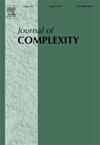Constructions of normal numbers with infinite digit sets
IF 1.8
2区 数学
Q1 MATHEMATICS
引用次数: 0
Abstract
Let be any ordered probability sequence, i.e., satisfying for each and . We construct sequences on the countably infinite alphabet in which each possible block of digits , , occurs with frequency . In other words, we construct L-normal sequences. These sequences can then be projected to normal numbers in various affine number systems, such as real numbers that are normal in GLS number systems that correspond to the sequence L or higher dimensional variants. In particular, this construction provides a family of numbers that have a normal Lüroth expansion.
具有无限位集的正常数的构造
设L=(Ld)d∈N为任意有序概率序列,即对于每个d∈N,∑d∈NLd=1,满足0<;Ld+1≤Ld。我们在可数无限字母N上构造序列A=(ai)i∈N,其中每个可能的数字块α1,…,αk∈N, k∈N,以频率∏d=1k αd出现。换句话说,我们构造l -正规序列。然后可以将这些序列投影到各种仿射数系统中的正规数,例如实数x∈[0,1],它在对应于序列L或高维变体的GLS数系统中是正规的。特别地,这种构造提供了一组具有正罗斯展开的数。
本文章由计算机程序翻译,如有差异,请以英文原文为准。
求助全文
约1分钟内获得全文
求助全文
来源期刊

Journal of Complexity
工程技术-计算机:理论方法
CiteScore
3.10
自引率
17.60%
发文量
57
审稿时长
>12 weeks
期刊介绍:
The multidisciplinary Journal of Complexity publishes original research papers that contain substantial mathematical results on complexity as broadly conceived. Outstanding review papers will also be published. In the area of computational complexity, the focus is on complexity over the reals, with the emphasis on lower bounds and optimal algorithms. The Journal of Complexity also publishes articles that provide major new algorithms or make important progress on upper bounds. Other models of computation, such as the Turing machine model, are also of interest. Computational complexity results in a wide variety of areas are solicited.
Areas Include:
• Approximation theory
• Biomedical computing
• Compressed computing and sensing
• Computational finance
• Computational number theory
• Computational stochastics
• Control theory
• Cryptography
• Design of experiments
• Differential equations
• Discrete problems
• Distributed and parallel computation
• High and infinite-dimensional problems
• Information-based complexity
• Inverse and ill-posed problems
• Machine learning
• Markov chain Monte Carlo
• Monte Carlo and quasi-Monte Carlo
• Multivariate integration and approximation
• Noisy data
• Nonlinear and algebraic equations
• Numerical analysis
• Operator equations
• Optimization
• Quantum computing
• Scientific computation
• Tractability of multivariate problems
• Vision and image understanding.
 求助内容:
求助内容: 应助结果提醒方式:
应助结果提醒方式:


